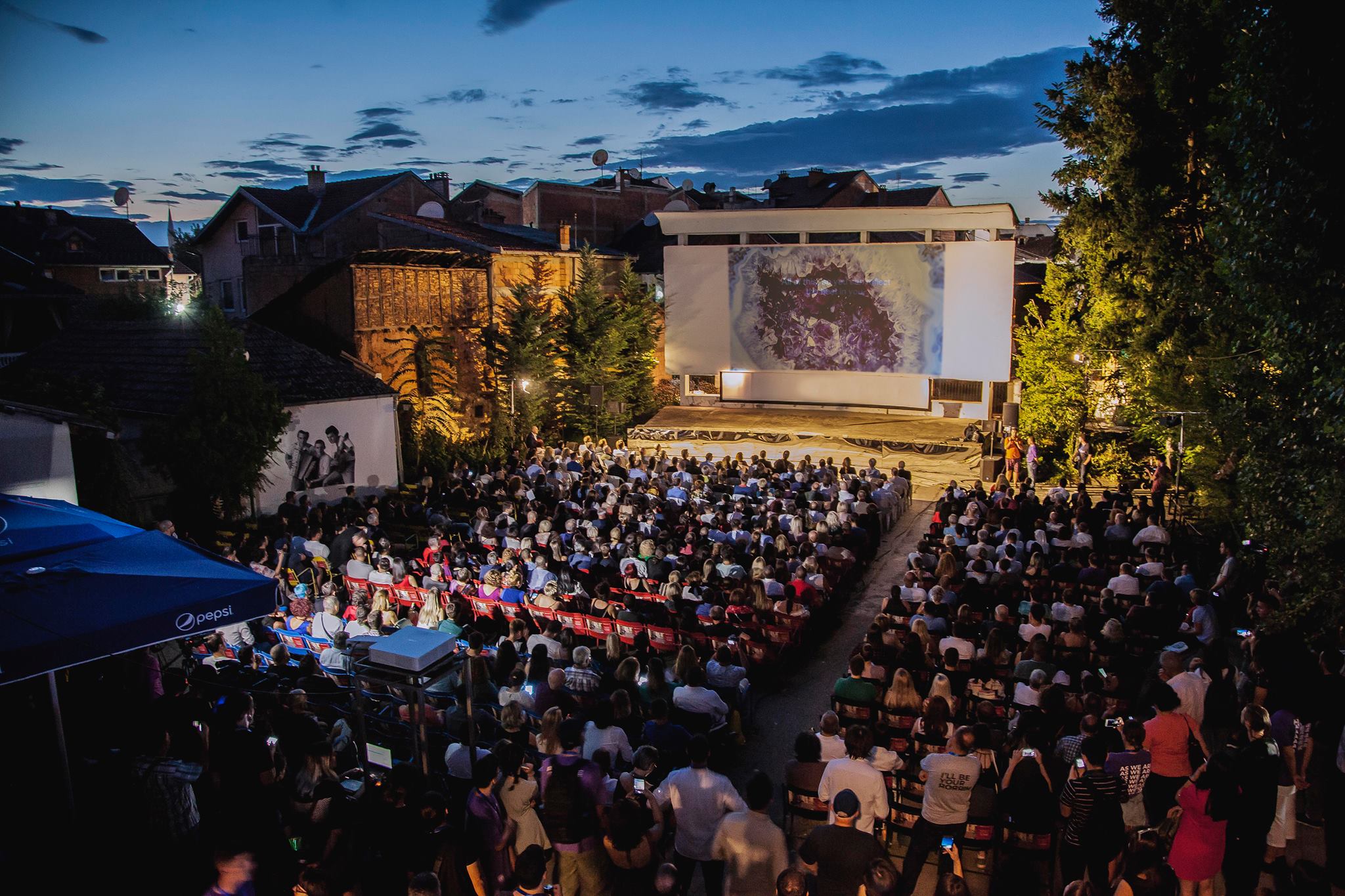
Lumbardhi Cinema was established in 1952 in Prizren, Kosovo, during the era of Socialist Yugoslavia. It was part of a modern cultural construction in a newly formed country, aiming to educate the masses with the new ideology through the medium of film. Initially, the cinema operated indoors, and in 1959, an outdoor cinema was also opened for public screenings. However, the cinema faced constant threats of demolition from its early years. In 1972, when the cinema was just 20 years old, authorities made a decision to demolish it. Later in the 1980s, an architectural contest was even held to redesign the entire neighborhood, including the cinema, as a major cultural complex. Despite these efforts, all attempts at demolition or redevelopment failed due to various reasons. In 2007, municipal authorities once again decided to demolish the cinema, posing a more serious threat with demolition machines on standby. Fortunately, a last-minute civil resistance initiative managed to halt the demolition, saving the cinema from destruction.
“The opening ceremony of DokuFest was replaced with an act of protest which later gathered the support of 58 civil society organizations from across Kosovo, the public and many institutional stakeholders. It was a remarkable success and marked the first step towards saving the Lumbardhi Cinema.”
Ares Shporta, Lumbardhi Foundation
The “Initiative for Protection of Lumbardhi Cinema” initiative, led by DokuFest and EC Ma Ndryshe, first successfully gathered over 8,000 signatures and organized protests to exert public pressure on the authorities, effectively preventing the impending demolition. However, there was no subsequent action taken to activatethe cinema which had closed after the war. Although the cinema informally reopened as SHKA – Shoqeria Kulturo Artistike on private initiative for a brief period of two years between 2012-2014, with a bar and event space operating on the premises, for the better part of 7 years there were no institutional efforts made to reactivate the cinema and restore it for public use, explains Ares Shporta, the Director of Lumbardhi Foundation. In 2014, another and final attempt was made to demolish the cinema, through privatisation by AKP and municipality’s plans to “widen the road”, re-opening the debates for a parking lot or a shopping mall, as it happened in many cities in the region
Ares recounts that the decision to demolish the cinema was announced three weeks prior to the internationally renowned film festival, DokuFest, which is held annually in Prizren and utilizes the cinema as its main venuesince 2002 ,” he adds.
The failure of the previous demolition attempt served as a valuable lesson, prompting activists in Prizren to take decisive action and establish the Lumbardhi Foundation as an independent non-governmental organization. Their mission was to reclaim the cinema as a cultural heritage site accessible to all and proactively advocate for the implementation of the 7 goals of the initiative. Under the foundation’s initiative, apart from the emergency interventions on the roof and small-scale interventions that made the cinema more usable, the restoration of the open-air cinema, also known as Kino Bahç e, was undertaken between 2019 and 2020 in collaboration with CHwB Kosova and design of Khora Office through a project managed by UNDP and funded by the European Union. Subsequently, the detailed design for the comprehensive restoration plan for the cinema complex and the sidewalk was implemented in autumn 2022 .
In parallel, the Lumbardhi Foundation facilitated a collaborative process involving multiple stakeholders to develop a management plan for the Lumbardhi Cinema. The plan aimed to safeguard the cinema’s cultural heritage significance, foster sustainable socio-economic development, revitalize it as a public cultural center, and integrate it into the cultural fabric of Prizren. To achieve these goals, the foundation brought together artists, social scientists, and researchers who embarked on various projects, generating new knowledge and engaging with a wide audience.
In pursuit of a sustainable economic model, the Lumbardhi Cinema successfully combined self-generated income from the cafe, rental revenue, and ticket sales with external funding sources. As a result, the foundation now employs over 12 staff members and collaborates with approximately 10 external associates, making a positive contribution to the local economy.

“Our case demonstrates that demolition and building from scratch are not the only options. Reusing a building by restoring and enhancing its historical, social, and artistic values can make it functional again.”
Ares Shporta, Lumbardhi Foundation
During the latest attempt to demolish the cinema in 2014, the European Union strongly supported the citizens’ initiative for its protection. Subsequently, in 2018, the European Union pledged also a significant support, providing €1.5 million in funding for the future restoration of the cinema. The restoration project involves the installation of new heating, ventilation, and cooling systems, the adaptation of backstage and work spaces, the preservation of notable areas like the balcony and screening room, and the maintenance of other elements that contribute to the cinema’s unique identity. Additionally, the project will facilitate the creation of a café space and incorporate external interventions to align with urban planning.
“The support from the European Union is crucial, as the cinema currently operates in full capacity for only five months each year. With the completion of the restoration, it will be possible to utilize the cinema during the winter and autumn seasons for film screenings, concerts, plays, and similar activities,” explains Ares. He further highlights that the EU-funded project will enhance the building’s profitability, resulting in increased revenues. Moreover, from an aesthetic standpoint, the building will become more appealing to the general public. “Our action demonstrates that demolition and starting anew are not the only options. Reusing a building by revitalizing and preserving its historical, social, and artistic values can make it functional again,” adds Ares.
About the programme
The Instrument for Pre-accession Assistance (IPA) is the means by which the EU has been supporting reforms in the enlargement region with financial and technical assistance since 2007. IPA funds build up the capacities of the beneficiaries throughout the accession process, resulting in progressive, positive developments in the region.
For the period 2007-2013, the Instrument for Pre-accession Assistance (IPA) had a budget of €11.5 billion. Its successor, IPA II, was allocated €12.8 billion for the period 2014-2020. For the multiannual financial framework period 2021-2027, the IPA III budgetary envelope is €14.162 billion.
Photo credits: Lumbardhi Foundation, Majlinda Hoxha, Elmedina Arapi
The “Initiative for Protection of Lumbardhi Cinema” initiative, led by DokuFest and EC Ma Ndryshe, first successfully gathered over 8,000 signatures and organized protests to exert public pressure on the authorities, effectively preventing the impending demolition. However, there was no subsequent action taken to activatethe cinema which had closed after the war. Although the cinema informally reopened as SHKA – Shoqeria Kulturo Artistike on private initiative for a brief period of two years between 2012-2014, with a bar and event space operating on the premises, for the better part of 7 years there were no institutional efforts made to reactivate the cinema and restore it for public use, explains Ares Shporta, the Director of Lumbardhi Foundation. In 2014, another and final attempt was made to demolish the cinema, through privatisation by AKP and municipality’s plans to “widen the road”, re-opening the debates for a parking lot or a shopping mall, as it happened in many cities in the region
Ares recounts that the decision to demolish the cinema was announced three weeks prior to the internationally renowned film festival, DokuFest, which is held annually in Prizren and utilizes the cinema as its main venuesince 2002 ,” he adds.
The failure of the previous demolition attempt served as a valuable lesson, prompting activists in Prizren to take decisive action and establish the Lumbardhi Foundation as an independent non-governmental organization. Their mission was to reclaim the cinema as a cultural heritage site accessible to all and proactively advocate for the implementation of the 7 goals of the initiative. Under the foundation’s initiative, apart from the emergency interventions on the roof and small-scale interventions that made the cinema more usable, the restoration of the open-air cinema, also known as Kino Bahç e, was undertaken between 2019 and 2020 in collaboration with CHwB Kosova and design of Khora Office through a project managed by UNDP and funded by the European Union. Subsequently, the detailed design for the comprehensive restoration plan for the cinema complex and the sidewalk was implemented in autumn 2022 .
In parallel, the Lumbardhi Foundation facilitated a collaborative process involving multiple stakeholders to develop a management plan for the Lumbardhi Cinema. The plan aimed to safeguard the cinema’s cultural heritage significance, foster sustainable socio-economic development, revitalize it as a public cultural center, and integrate it into the cultural fabric of Prizren. To achieve these goals, the foundation brought together artists, social scientists, and researchers who embarked on various projects, generating new knowledge and engaging with a wide audience.
In pursuit of a sustainable economic model, the Lumbardhi Cinema successfully combined self-generated income from the cafe, rental revenue, and ticket sales with external funding sources. As a result, the foundation now employs over 12 staff members and collaborates with approximately 10 external associates, making a positive contribution to the local economy.

During the latest attempt to demolish the cinema in 2014, the European Union strongly supported the citizens’ initiative for its protection. Subsequently, in 2018, the European Union pledged also a significant support, providing €1.5 million in funding for the future restoration of the cinema. The restoration project involves the installation of new heating, ventilation, and cooling systems, the adaptation of backstage and work spaces, the preservation of notable areas like the balcony and screening room, and the maintenance of other elements that contribute to the cinema’s unique identity. Additionally, the project will facilitate the creation of a café space and incorporate external interventions to align with urban planning.
“The support from the European Union is crucial, as the cinema currently operates in full capacity for only five months each year. With the completion of the restoration, it will be possible to utilize the cinema during the winter and autumn seasons for film screenings, concerts, plays, and similar activities,” explains Ares. He further highlights that the EU-funded project will enhance the building’s profitability, resulting in increased revenues. Moreover, from an aesthetic standpoint, the building will become more appealing to the general public. “Our action demonstrates that demolition and starting anew are not the only options. Reusing a building by revitalizing and preserving its historical, social, and artistic values can make it functional again,” adds Ares.
About the programme
The Instrument for Pre-accession Assistance (IPA) is the means by which the EU has been supporting reforms in the enlargement region with financial and technical assistance since 2007. IPA funds build up the capacities of the beneficiaries throughout the accession process, resulting in progressive, positive developments in the region.
For the period 2007-2013, the Instrument for Pre-accession Assistance (IPA) had a budget of €11.5 billion. Its successor, IPA II, was allocated €12.8 billion for the period 2014-2020. For the multiannual financial framework period 2021-2027, the IPA III budgetary envelope is €14.162 billion.
Photo credits: Lumbardhi Foundation, Majlinda Hoxha, Elmedina Arapi
Please wait while your video is being uploaded...
Don't close this window!